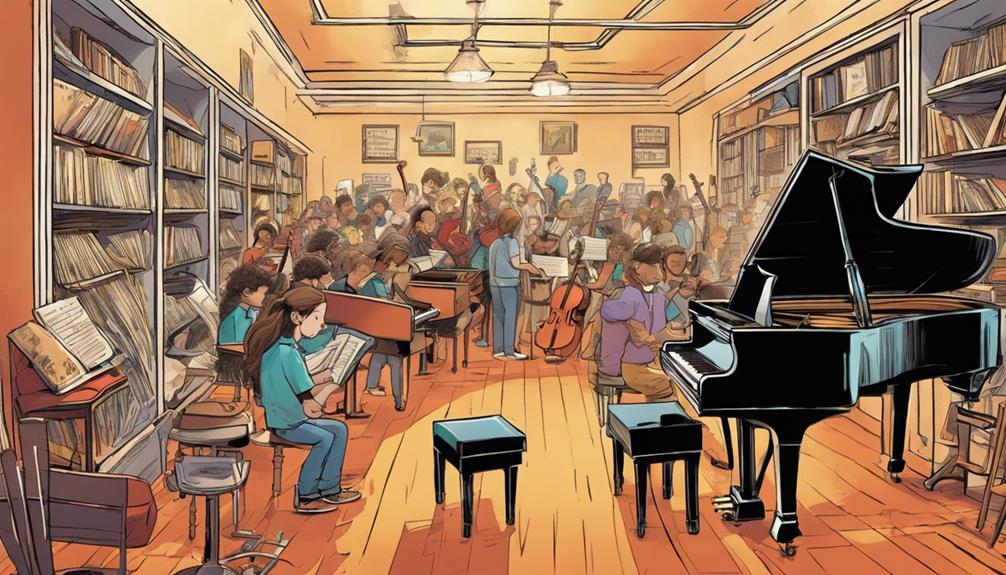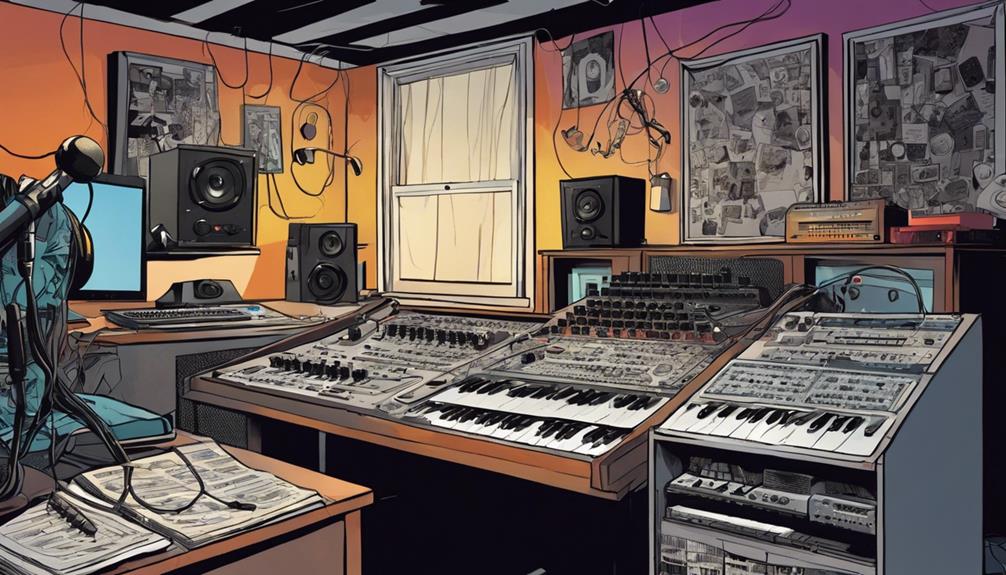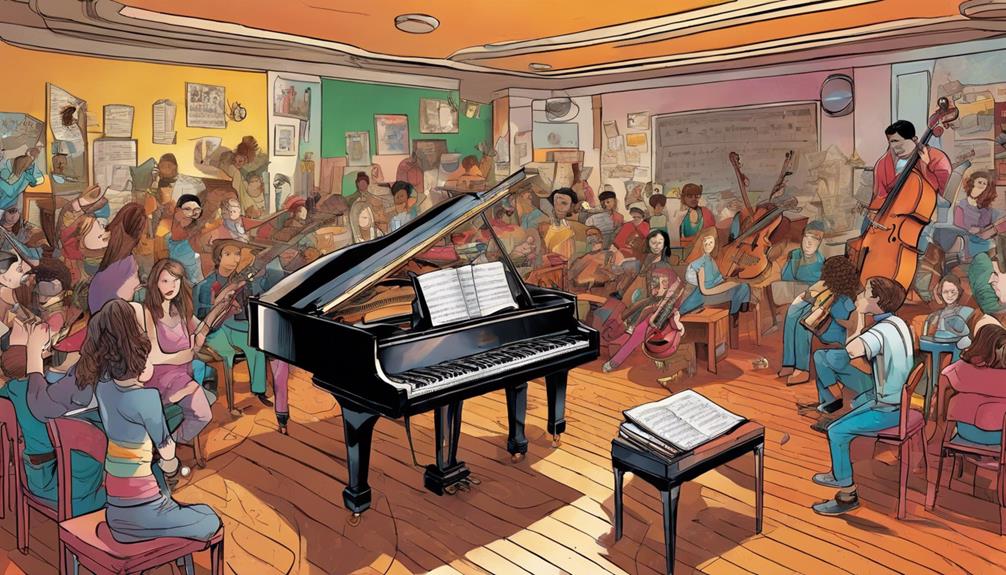To turn your dream of opening a music school into a reality, you'll need to establish a clear vision and mission statement to guide your decision-making. Identify your target audience through market research and tailor your offerings to meet their needs. Create a thorough music curriculum that sets clear learning objectives and aligns with industry standards. Secure a suitable location that's visible, accessible, and safe, and invest in high-quality equipment and experienced instructors. Finally, develop marketing and networking strategies, and build a strong online presence to attract students. By following these steps, you'll be well on your way to turning your dream into a successful music school – and there's more to learn about each of these essential steps.
Key Takeaways
- Define a clear vision and mission statement to guide decision-making and inspire your music school's growth.
- Conduct market research to identify your target audience and tailor your offerings to meet their needs.
- Create a comprehensive music curriculum that sets clear learning objectives and aligns with industry standards.
- Secure a visible, accessible, and safe location that aligns with your community vision and invest in quality equipment.
- Develop a marketing and networking strategy that includes online presence, referral incentives, and local music event collaborations.
Defining Your Music School's Vision
As you commence on the exciting journey of opening your own music school, defining a clear vision is essential to guide your decision-making, inspire stakeholders, and set your institution apart from others in the industry.
Your music school vision serves as a roadmap, outlining what you want to achieve and the values you want to uphold. It's important to establish specific goals and objectives that align with your vision, ensuring everyone involved is working towards the same targets.
A well-crafted mission statement will also help convey your school's purpose and values to stakeholders. To ensure a cohesive identity, your vision, mission, and core values must align.
Finally, a communication strategy is critical to share your vision with staff, students, and the community, gaining buy-in and support. By defining your music school's vision, you'll create a strong foundation for your institution, enabling you to make informed decisions and drive success.
With a clear vision, you'll be better equipped to overcome challenges and achieve your goals, ultimately establishing a thriving music school that makes a positive impact on your students and community.
Identifying Your Target Audience
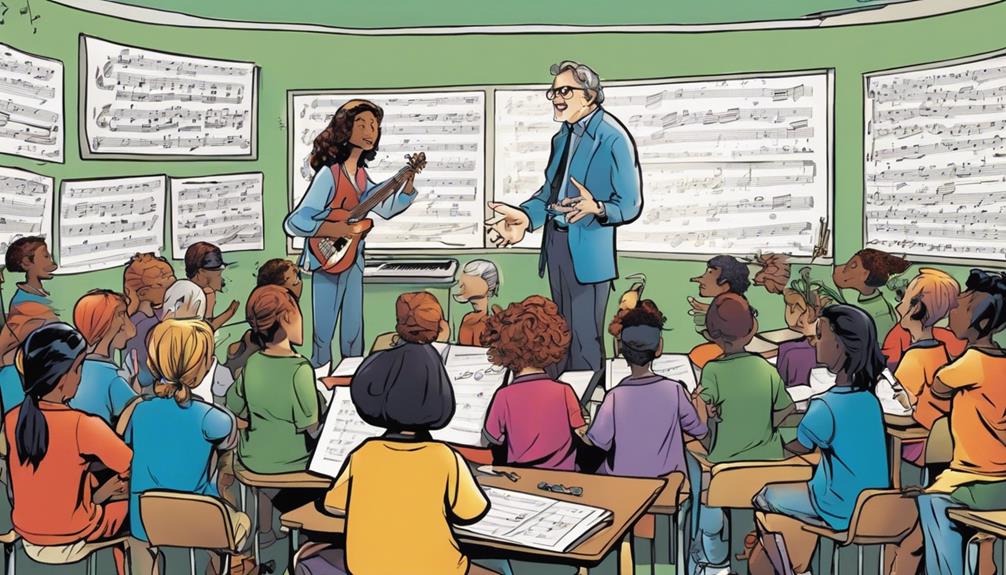
With a clear vision in place, you can now focus on identifying the specific group of students and families your music school will cater to, a critical step in shaping your programs and marketing strategy. To do this, you'll need to conduct market research to determine the age group, musical preferences, and skill levels of potential students. This will help you tailor your offerings to meet their needs and interests.
It's also essential to analyze the demographic characteristics of your target audience, including their geographic location, income levels, and educational backgrounds. This information will enable you to set appropriate pricing and programs. Don't forget to analyze the competition in your area to understand the demand for music education and identify potential niches to target.
Utilize surveys, focus groups, and social media analytics to gather insights on the interests and needs of your target audience. By doing so, you'll be able to create a music school that resonates with your community and sets you apart from the competition.
Creating a Music Curriculum

As you set out to create a music curriculum for your school, you'll need to establish clear goals and a well-defined course structure. This will involve determining what you want your students to achieve, and how you'll help them get there.
Set Curriculum Goals
Developing a thorough music curriculum that meets the diverse needs of your students requires establishing clear learning objectives and goals for each music program offered in your school. This important step guarantees that your curriculum remains focused, effective, and aligned with industry standards.
When setting curriculum goals, consider the specific needs and skill levels of your students. What do you want them to achieve in each music program? What skills do you want them to develop? By establishing clear learning objectives, you can design a music curriculum that's tailored to meet the unique needs of your students.
Your curriculum goals should be specific, measurable, achievable, relevant, and time-bound (SMART). For instance, a goal for a beginner's guitar program might be to teach students to play basic chords and simple melodies within the first three months. By setting SMART goals, you can track student progress, identify areas for improvement, and make data-driven decisions to refine your music curriculum.
Define Course Structure
As you initiate the creation of a music school, defining a course structure is essential to provide a thorough learning experience for your students. You'll need to create a detailed course structure that incorporates a variety of musical styles, techniques, and genres to cater to the diverse needs and interests of your students.
To achieve this, consider the following key elements to include in your curriculum structure:
| Element | Description | Benefits |
|---|---|---|
| Music Theory | Understanding notes, scales, chords, and rhythm | Builds foundation for musical knowledge |
| Ear Training | Developing skills to recognize and replicate melodies | Enhances musicality and improvisation |
| Performance Skills | Mastering instrumental or vocal techniques | Boosts confidence and stage presence |
| Improvisation | Encouraging creative expression and experimentation | Fosters musical growth and creativity |
Securing a Suitable Location

One key factor to take into account when securing a suitable location for your music school is its visibility, as a high-traffic area can greatly impact your school's exposure and attractiveness to potential students. A location with high visibility can enhance your marketing efforts and attract more students to your school.
When evaluating potential locations, consider the following:
- Accessibility and safety: Guarantee the location is easily accessible and safe for students, particularly if you're targeting families with young children.
- Proximity to schools: Being close to schools can be beneficial, as you can attract students who are already in the area for their daily education.
- Alignment with community vision and target audience: Choose a location that aligns with your community vision and target audience preferences to maximize appeal.
Investing in Quality Equipment
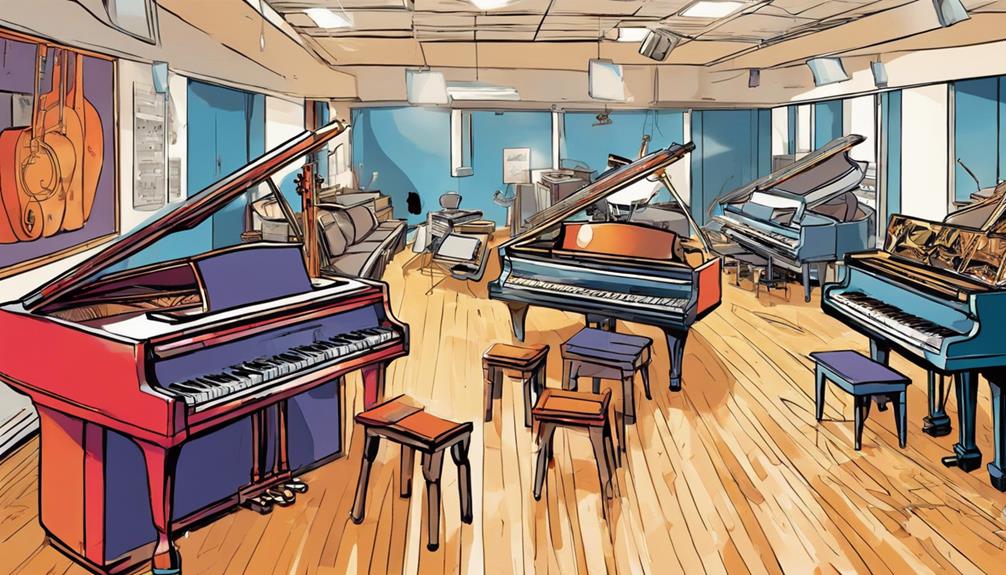
As you prepare to open your music school, investing in quality equipment is vital to providing an exceptional learning experience for your students.
You'll need to think about essential instrumental tools, sound quality, and acoustic room design to create an environment that inspires learning and creativity.
Essential Instrumental Tools
You'll want to invest in high-quality instruments and equipment that will provide your students with the best possible learning experience from day one. This is essential in fostering a positive and engaging environment that motivates students to learn and improve. High-quality instruments can enhance student engagement, motivation, and overall enjoyment of lessons, leading to better learning outcomes.
Here are three essential instrumental tools to explore:
- Acoustic pianos: A must-have for any music school, acoustic pianos offer a rich, authentic sound that's ideal for teaching technique and expression.
- Digital audio workstations: These software tools allow students to record, edit, and produce their own music, providing a thorough understanding of the music production process.
- Professional-grade microphones: High-quality microphones are vital for capturing clear, crisp sound during performances and recordings, helping students develop their skills in a real-world setting.
Sound Quality Matters
Set yourself up for success by investing in high-quality equipment that elevates the sound quality of your music school, from sound systems and instruments to recording gear, to create an immersive learning environment that attracts students and sets your school apart from the competition.
High-quality equipment is essential for providing an exceptional learning experience. It enhances the sound quality of lessons, recordings, and performances, making a significant impact on the learning process, student engagement, and overall success of your music school.
Here are some key considerations when investing in equipment:
| Equipment | Benefits | Impact on Music Education |
|---|---|---|
| Sound Systems | Clear and balanced sound, enhanced student engagement | Improved learning environment, increased student motivation |
| Instruments | High-quality tone, durability, and playability | Enhanced student performance, increased confidence |
| Recording Gear | Professional-grade recordings, improved sound quality | Increased student satisfaction, better assessment of progress |
Acoustic Room Design
Design your music school's rooms with acoustic excellence in mind, incorporating sound-absorbing materials, diffusion strategies, and reflection management to create an ideal learning environment.
A well-designed acoustic room is essential for creating a conducive environment for music learning. Investing in quality equipment guarantees excellent sound quality and student experience.
Here are three key factors to take into account in acoustic room design:
- Sound Absorption: Use materials like acoustic panels, soundproofing, and carpets to minimize echo and reverberation, allowing students to focus on their music.
- Diffusion: Strategically place diffusers to scatter sound waves, creating a more even sound distribution and reducing hotspots.
- Reflection: Manage sound reflection by placing sound-absorbing materials at strategic points, ensuring that sound waves don't bounce back and cause distractions.
Hiring Experienced Instructors
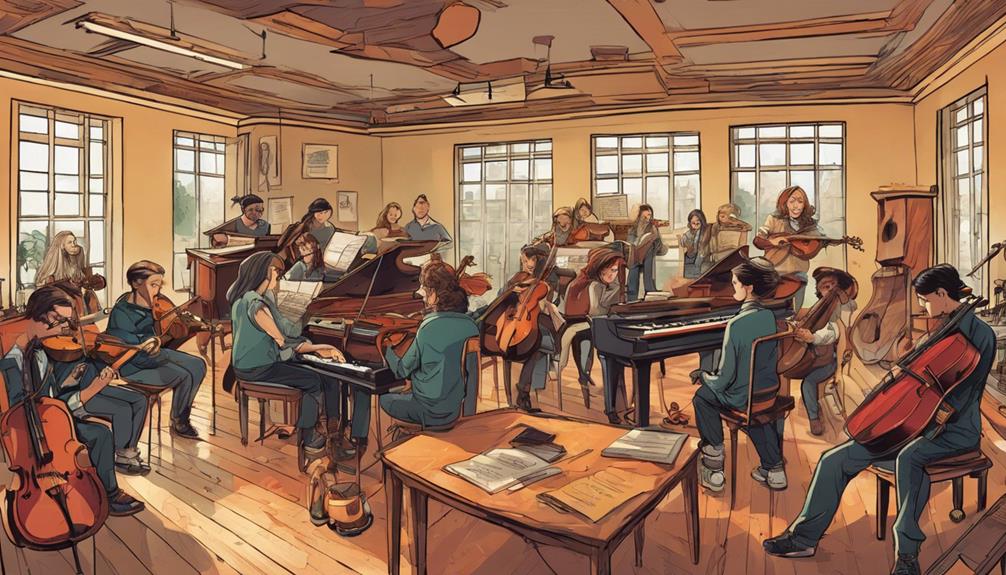
When assembling your music school's teaching staff, it's vital to prioritize hiring experienced instructors who can offer high-quality instruction and mentorship to your students. Look for instructors with a minimum of 5 years of teaching experience in music education, as they'll have a deeper understanding of how to engage and inspire students.
Prioritize hiring instructors with a strong educational background in music theory and performance, as this will enable them to provide well-rounded instruction. It's also important to seek out instructors with a proven track record of student success and positive reviews, as this will give you confidence in their ability to deliver results.
Consider hiring instructors who specialize in specific instruments or genres to diversify your teaching staff and cater to a broad range of students. Finally, make sure that all instructors have the necessary certifications and qualifications to teach music effectively.
Marketing and Networking Strategies

To attract students and build a strong reputation, you'll need to develop a thorough marketing strategy that showcases your music school's unique strengths and values. This strategy should involve utilizing social media platforms to promote your school and engage with potential students and parents. By creating a strong online presence, you can share updates, announcements, and success stories that highlight your school's accomplishments.
Here are three key marketing and networking strategies to explore:
- Attend local music events: Network with musicians, teachers, and community members at local events, workshops, and fairs to establish relationships and partnerships.
- Collaborate with local organizations: Partner with local schools, community centers, and music stores to reach a broader audience and build credibility.
- Offer referral incentives: Encourage current students and parents to refer new students by offering incentives, such as discounts or free lessons, to boost enrollment and drive growth.
Building a Strong Online Presence

By establishing a professional online presence, you'll be able to reach a wider audience, build credibility, and attract potential students to your music school. A strong online presence is vital in today's digital age, and it's imperative to have a solid strategy in place.
Here are some key elements to focus on:
| Element | Description |
|---|---|
| Professional Website | Showcase your music school's services, instructors, and testimonials |
| Social Media | Engage with potential students on Facebook, Instagram, and YouTube |
| Virtual Tours | Give prospective students a glimpse of your facilities through videos and interactive content |
| Blog Posts | Share informative content about music education, student success stories, and industry trends |
| Online Registration | Streamline the enrollment process with online registration and payment systems |
Frequently Asked Questions
How to Start a Music School?
'You're enthusiastic to start a music school. To begin, identify your niche, define your mission, and develop a business plan outlining budget, marketing, and operations – then, find a location and assemble a team of qualified instructors!'
How Much Do Music School Owners Make?
You can earn an average annual salary of $40,000 to $80,000 as a music school owner, but successful owners can make over $100,000 through multiple revenue streams and additional income sources.
How to Start a Music School in India?
'As you commence on a melodic journey to start a music school in India, imagine sowing seeds of rhythm in fertile soil. Begin by understanding the local market, cultural preferences, and regulatory requirements, then nurture your vision with a tailored curriculum and strategic collaborations.'
How to Start a Music School in the Uk?
To start a music school in the UK, you'll need to obtain necessary licenses and permits, choose a prime location, research the local market, and develop a tailored business plan to succeed in this competitive industry.
Conclusion
So, you've finally made it – you're about to open your own music school. Congratulations, you've survived the grueling process of defining your vision, identifying your target audience, creating a curriculum, securing a location, investing in equipment, hiring instructors, and marketing your school. Now, the real adventure begins as you prepare to welcome students and bring your vision to life. Starting this journey is no small feat, and the passion and dedication that drove you to start your own music school will be the foundation of its success. As the doors open, you’re not just teaching music—you’re creating a place where creativity and talent can truly thrive.
Now, all you have to do is deal with the paperwork, the parents, and the piano tuners. Just kidding (kind of). Seriously, though, you've got this. Start teaching, and remember to breathe.

